
Barea codrella, the barea moth, is a moth of the family Oecophoridae. It is found in Australia, more specifically Tasmania, New South Wales and Victoria and South Australia. It is also an adventive species in New Zealand.

Macarostola miniella is a species of moth in the family Gracillariidae. It is endemic to New Zealand. This species is only found in the North Island and the adult moths have two different colour variations.
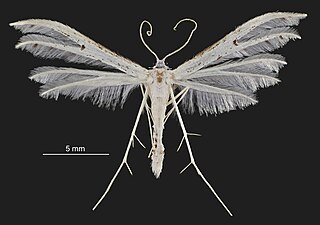
Pterophorus monospilalis, the white plume moth, is a moth of the family Pterophoridae. It is endemic to New Zealand and occurs throughout the country. It inhabits native forest, parks and domestic gardens. Larvae are active during the day, are slow moving, and feed exposed. They feed on Araliaceae species as well as on Hedera helix, Meryta sinclairii, and Schefflera digitata. There are several broods in a year. Adult moths are on the wing from November until May and are attracted to light.

Epiphryne undosata, also known as the lacebark looper, is a moth of the family Geometridae. It is endemic to New Zealand and is found on both the North and South Islands. It inhabits native forest. The larvae feed on plant species in the genera Hoheria and Plagianthus. They pupate amongst dead leaves in a silk cocoon. The adult moths have been observed on the wing all year round but are most commonly seen from November until February. The adult moths are extremely variable in both their colour intensity and wing pattern.
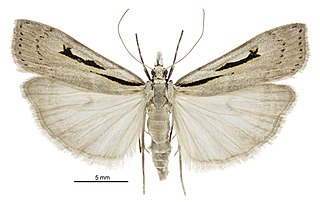
Scoparia rotuella is a species of moth in the family Crambidae. It was first described by Cajetan Felder, Rudolf Felder and Alois Friedrich Rogenhofer in 1875. It is endemic to New Zealand and, although considered localised, is found throughout the country. As at 2022 the life history of this species is largely unknown, but it has been hypothesised that this species may have two broods a year. Adults are on the wing all year round and are attracted to light.

Scoparia ustimacula, also known as the black-marked brown Scoparia moth, is a species of moth in the family Crambidae. It was described by Cajetan Felder, Rudolf Felder and Alois Friedrich Rogenhofer in 1875. It is endemic to New Zealand and can be found in the North, South and Stewart Islands. This species inhabits dense native forest at altitudes from sea level to approximately 1000 m. Although little is known of the life history of this species, larvae have been observed feeding on Hydrocotyle species. Adults are on the wing year round but are more commonly observed from September to March. Adults are nocturnal, are attracted to light and have been collected by beating scrub.

Apoctena taipana is a species of moth of the family Tortricidae. It is endemic to New Zealand and has been observed in both the North and South Islands. The larvae created a silken tube in which they hide and also use to travel from leaf to leaf. They tunnel into the leaves of their host. Larvae can be found from June to August. Adult moths can be seen on the wing from October to January.

Gadira acerella is a moth in the family Crambidae. It was first described by Francis Walker. It is endemic to New Zealand and is found throughout the country. The species inhabits native forest from sea level up to subalpine altitudes. Larvae are assumed to feed on lichen or moss. Adults are on the wing from October until March, are active at night and are attracted to light. This species is distinctively patterned and coloured and is said to resemble a bird dropping at rest. The colouring also assists to camouflage the moth when it rests against lichen.

Orocrambus tuhualis is a moth in the family Crambidae. It was described by Cajetan Felder, Rudolf Felder and Alois Friedrich Rogenhofer in 1875. It is endemic to New Zealand, where it has been recorded in the South Island and Wellington in the North Island. This species prefers habitat that consists of swampy areas.
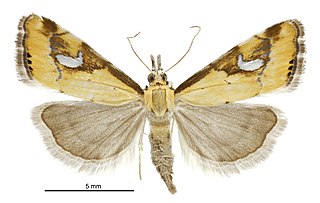
Glaucocharis lepidella is a species of moth in the family Crambidae. It was described by Francis Walker in 1866. It is endemic to New Zealand and is found in both the North and South Island. The species inhabits lowland to subalpine native forest. Larvae may feed on mosses. Adults are on the wing from November to February and are attracted to light.
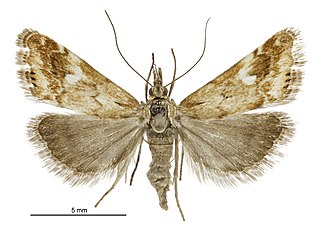
Glaucocharis helioctypa is a moth in the family Crambidae. It was described by Edward Meyrick in 1882. It is endemic to New Zealand.

Glaucocharis leucoxantha is a moth in the family Crambidae. It was described by Edward Meyrick in 1882. It is endemic to New Zealand.
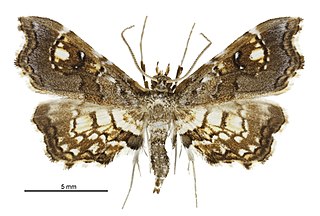
Musotima aduncalis, also known as the maidenhair fairy moth, is a moth in the family Crambidae. It was described by Cajetan Felder, Rudolf Felder and Alois Friedrich Rogenhofer in 1875. This species is endemic to New Zealand.
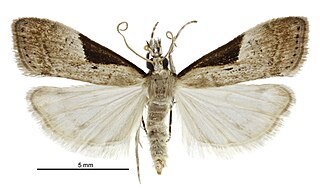
Eudonia pongalis is a moth in the family Crambidae. It was described by Cajetan Felder, Rudolf Felder and Alois Friedrich Rogenhofer in 1875. It is endemic to New Zealand.
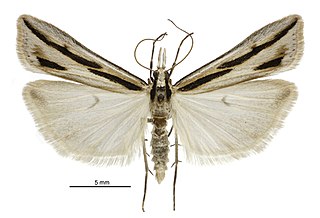
Eudonia trivirgatus is a moth in the family Crambidae. It was first described by Cajetan Felder, Rudolf Felder and Alois Friedrich Rogenhofer in 1875 as Crambus trivirgatus. It is endemic to New Zealand.
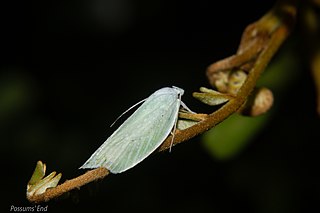
Nymphostola is a monotypic moth genus in the family Oecophoridae or the family Depressariidae. The genus was erected by Edward Meyrick in 1883. Its only species, Nymphostola galactina, the tarata flat moth, was described by Cajetan Felder, Rudolf Felder and Alois Friedrich Rogenhofer in 1875. It is endemic to New Zealand.

Dichromodes sphaeriata is a moth of the family Geometridae. It is endemic to New Zealand.
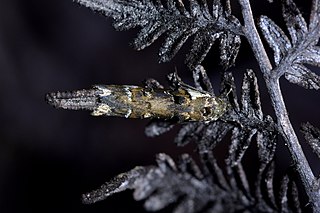
Trachypepla conspicuella is a species of moth in the family Oecophoridae. It is endemic to New Zealand and is found in both the North and South Islands. It is similar in appearance to its close relative T. euryleucota but tends to be paler. Its colouration imitates bird droppings. Larvae feed on leaf litter. Adults of this species are on the wing from November to February and have been observed resting on fences and walls.

Ischalis nelsonaria, also known as the angled fern looper, is a species of moth of the family Geometridae. It was first described in 1875. This species is endemic to New Zealand and has been observed in both the North and South Islands. I. nelsonaria inhabits native forest. The larval host of this species is Zealandia pustulata. Larvae have also been raised on Blechnum novae-zelandiae. Adult moths of this species are variable in appearance and are nocturnal. They have been observed on the wing throughout the year but are most frequently observed in February and March. They have been observed feeding on the flowers of Metrosideros diffusa.

Pseudocoremia lupinata is a species of moth in the family Geometridae. It is endemic to New Zealand and can be found in both the North and South Islands. The favoured habitat of this species is Kānuka scrubland as its larval hosts are species in the genus Kunzea. Both the larvae and adults of this species are nocturnal. Adult moths are commonly on the wing from December to June and are attracted to light.























